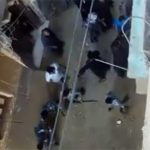By WSJ —
A series of blasts tore through churches and international hotels in Sri Lanka on Easter morning, killing at least 207 people and wounding more than 450 in a coordinated series of attacks on tourists and the country’s minority Christian community.
At least eight explosions, most attributed to suicide bombers, took place across the country, turning restaurants and prayer halls that moments earlier were hosting joyful services and holiday feasts into chaos of rubble, broken furniture, shards of glass and the wounded and dead.
Seven people were arrested in Colombo in connection with the bombings, State Minister of Defense Ruwan Wijewardene said. Authorities didn’t provide further details about those in custody.
Mr. Wijewardene said that all social media had also been temporarily banned after the attacks while a curfew was imposed on the entire country. Remaining Easter masses were canceled.
Scenes of destruction and injured worshipers and other victims were broadcast by local news stations from several of the churches, one in the capital, one just outside the capital and third in the east of the country. Damage was also reported at three international hotels in Colombo popular with foreign tourists, the Shangri-La Hotel, the Kingsbury hotel and the Cinnamon Grand Hotel.
Another blast occurred in a tourist district near the city zoo in Colombo. At least nine international tourists were confirmed dead by the main hospital in Colombo, according to a spokesman there. Officials said they believed visitors from China, the U.S., England and Belgium may be among the deceased.
“We heard a deafening noise and a shock wave knocked us onto the ground. Initially I didn’t know what to do,” said Sujeewa Perera, who was passing by the Cinnamon Grand Hotel with a friend near Colombo’s seafront when the blast at one of the hotel’s restaurants occured. “There were people screaming and running everywhere. Someone helped me into a passing vehicle that dropped me off at the hospital. I still don’t know what happened to my friend.”
Hours after the blasts, people were still working to clear bodies from the attack sites. Helped by priests they combed through torn clothing, shards of wood from destroyed pews and building debris in search of survivors and then to remove the dead.
The attacks began about 9 a.m. local time, with six of the blasts taking place almost simultaneously. Those hit some of the capital’s biggest and most-frequented hotels along its waterfront. A church in the capital was hit, along with another hours away in the country’s east and a third just north of the capital.
Analysts said that targeting so many locations simultaneously with such deadly results indicated sophisticated planning.
“That eight separate suicide bombings took place within a matter of hours suggests the presence of a sophisticated terrorist infrastructure in the country,” said Kamran Bokhari, director of the Center for Global Policy, an independent think tank in Washington.
Sri Lanka’s Secretary of Defense, Hemasiri Fernando, said that the government had received warnings about possible attacks targeting religious sites but they were not specific enough to effectively act upon.
Prime Minister Ranil Wickremesinghe delivered a short statement from his official residence, calling on all Sri Lankans to remain “calm, united and strong.”
“Please avoid propagating unverified reports and speculation. The government is taking immediate steps to contain this situation,” Mr. Wickremesinghe said.
He later visited the church in Colombo that was attacked.
Father Edmond Tillekeratne, director of the Catholic archdiocese social communications center at St. Sebastian’s Church in the city of Negombo, north of the capital, said bodies of worshipers were still scattered around the church. At least 600 people had been inside for Easter service, he estimated, when the explosions occurred.
“The whole roof was shattered and there was flesh all over the walls and even outside the church,” he said, adding that the explosion seemed to come from the crowd.
In a video posted on social media, rescue workers could be seen speaking with parishioners at St. Sebastian’s amid the carnage. The ceiling above was blown apart and the morning sky could be seen through most of it. Other videos showed bloodied bodies draped across pews and piled atop each other in between them.
International condemnation of the bombings began to come in as the rest of the world awoke to the news.
President Trump offered condolences in a tweetSunday morning and European Commission President Jean-Claude Juncker said it was with horror and sadness that he heard of the attacks.
Sri Lanka, an island nation of 21 million people located off the southern coast of India, is a popular vacation destination for tourists from around the world. The country has attracted about 2 million tourists annually in recent years, from Asia, Europe, Russia and the U.S. among other places.
Sri Lanka suffered through a decadeslong civil war in which a government dominated by the Sinhalese-speaking Buddhist majority fought an insurgency drawn primarily from a Tamil-speaking minority.
That war ended in 2009, when the government killed the last fighters from the insurgent army, known as the Liberation Tigers of Tamil Eelam. Incidents of militant violence have declined since then, but tensions between the country’s Buddhist majority and various minority groups, including Tamils, have simmered in recent years.
The country also has a Muslim minority of about 10%. Christians make up about 5% of the population.
____________________
https://www.wsj.com/articles/sri-lanka-church-hotel-blasts-kill-dozens-11555827165



